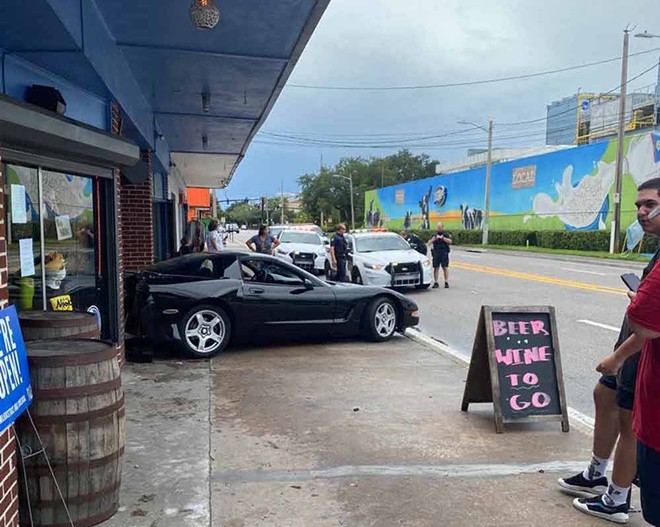Police tape still drapes the boarded-up entrance to the Milk District Spot on Robinson Street. In January, a car veered off the road and smashed into the storefront, leaving behind a chaotic scene of bricks and destruction. Then, in early March, a car jumped the curb on the same block and swiped the Bull and Bush. The British pub’s door was badly damaged.
The four-lane road in the heart of the Milk District is lined with bars and stores on its south side. They open up onto a sidewalk that gives way to the street with no protective buffer between pedestrians and cars. The cars zipping by are a palpable presence for people visiting the strip.
The two wrecks, as well as others in recent years near the corner of Robinson and Bumby Avenue, have prompted the Milk District to consider what safety measures it can take to protect the popular shops and bars on the street.
Zac Alfson, executive director of the Milk District Main Street District, tells Orlando Weekly business owners are frustrated.
“We luckily haven’t had any fatalities yet, but I think that really is about luck and that won’t last forever,” Alfson says. “They [the businesses] are facing real hard costs on building repairs and insurance.”
Short-term solutions are limited, but long-term fixes are complicated. The biggest challenge is that Robinson Street is also State Road 526, meaning the city of Orlando needs approval from the Florida Department of Transportation if it wants to make any changes.
Last Friday, Alfson met with Orlando Transportation Director Tanya Wilder, her department, and the city planning division to discuss solutions. While the state has a big makeover of the street in the works, Alfson was curious if some interim measures could be put in place to protect pedestrians and businesses.
The most viable solution to come from the meeting? A bulb-out, or widening of curbs at the intersection of Robinson and Bumby. A “quick curb” design would put a line of raised strips that hold up caution markers into the street, radiating out from the existing curb in the shape of the eventual bulb out. It would temporarily do the job of narrowing the roadway and slowing down traffic, if the state approves of the idea.
Cement curb extensions are part of FDOT’s ultimate plan for busy intersections on Robinson Street, which is State Road 526 from downtown to the executive airport. In 2019, the agency completed a planning and development study for Robinson. It proposed replacing the four lanes of traffic racing into and out of downtown with a pedestrian-friendly corridor.
The redesign would reduce Robinson to three lanes, including one turn lane interspersed with green medians. It also provides space for a two-way, protected bike lane near Lake Eola and creates on-street parking in front of Milk District businesses. According to FDOT’s website, resurfacing on the Milk District stretch is scheduled for November 2023.
Laura Hardwicke, Orlando’s transportation project manager, tells Orlando Weekly the city and FDOT are in sync on this plan. “We’re used to working with them on all of their roads that are within the city,” Hardwicke says. “While there’s more people at the table, it’s something we’re used to.”
An early suggestion to protect businesses and pedestrians on Robinson was bollards, or cement posts lining the sidewalk. That suggestion is not off the table, but Hardwicke says it could clash with long-term plans.
“Bollards on the sidewalk might treat the symptom of cars running into the buildings,” she says. “But it doesn’t necessarily address the trend in these crash reports, which is that speeding is an issue.”
The city is approaching FDOT with suggestions from last week’s meeting. It’s just phase one in a move toward greater safety, but Alfson calls it good news.
“We’re getting a response from the city where there wasn’t any before,” he says. “We’re looking to work closely with them on finding a solution that makes our patrons safe, businesses able to stay open and that preserves the assets of the property owners.”
Hardwicke says the street is a priority, but notes there are other parts of town that need attention, too. According to city data, seven of the 19 fatal pedestrian or bicycle crashes last year happened in District 5, which consists of downtown and west Orlando.
The city’s pedestrian safety record has been dismal for at least a decade, as Smart Growth America’s reporting has tracked. The organization’s “Dangerous by Design” reports rank states and metropolitan areas around the U.S. using their “Pedestrian Danger Index,” a combination of metrics that measures how deadly it is for people to walk based on the number of people struck and killed by drivers while walking.
The 2021 index named Orlando the most deadly metro area for walkers in the country. The region has topped five of six “Dangerous by Design” reports since 2009.
There are signs the city is focused on getting better. In 2017, it adopted a Vision Zero Action Plan that aims to eliminate traffic fatalities and serious injuries within the city by 2040. The Vision Zero dashboard makes crash information accessible to the public.
The regional transportation organization MetroPlan Orlando has backed the complete streets model that puts walking, biking and public transportation at the forefront. And Wilder, who wants to fix Orlando’s car-reliant hellscape, is one year into her tenure as transportation director. The faster the city can move toward Wilder’s vision of a less car-centric place, the safer it will make everyone.
[email protected]

